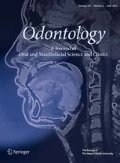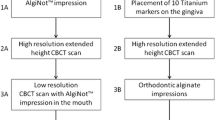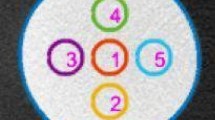Abstract
The aim of this study is to evaluate the accuracy of dental ceramic object three dimensional (3D) finite element model constructed directly from two different dental cone beam computed tomography (CT) systems. CT scanned one 10.0 × 10.0 × 20.0 mm block and one 8.0 × 10.0 × 40.0 mm block of an 8-step wedge. All 3D finite element (FE) models were created from CT images. Each 3D FE model measured the length of the directions X, Y, and Z that corresponded to an original specimen using the measurement function between two points on the Mechanical Finder software package. The measurements and practical value were compared with the CT image and the accuracy of the reproduced measurements was examined. No significant differences were found between Alphard-3030 on the Z axis and ProMax 3D on the Y axis of the block. In addition, there were also no significant differences observed between Alphard-3030 on the Y axis and ProMax 3D on the X axis compared with Alphard-3030 on the Z axis and ProMax 3D on the Y axis for the step-wedge. The results suggest that measurement of the dimensions of cone beam CT images could be useful in applications where both good reproducibility and accuracy of FE models are required.





Similar content being viewed by others
References
Korioth TW, Versluis A. Modeling the mechanical behavior of the jaws and their related structures by finite element (FE) analysis. Crit Rev Oral Biol Med. 1997;8:90–104.
Ausiello P, Apicella A, Davidson CL, Rengo S. 3D-finite element analyses of cusp movements in a human upper premolar, restored with adhesive resin-based composites. J Biomech. 2001;34:1269–77.
Ausiello P, Apicella A, Davidson CL. Effect of adhesive layer properties on stress distribution in composite restorations a 3D finite element analysis. Dent Mater. 2002;18:295–303.
Ausiello P, Rengo S, Davidson CL, Watts DC. Stress distributions in adhesively cemented ceramic and resin-composite class II inlay restorations: a 3D-FEA study. Dent Mater. 2004;20:862–72.
Cattaneo PM, Dalstra M, Frich LH. A three-dimensional finite element model from computed tomography data: a semi-automated method. Proc Inst Mech Eng [H]. 2001;215:203–13.
Cattaneo PM, Dalstra M, Melsen B. The transfer of occlusal forces through the maxillary molars: a finite element study. Am J Orthod Dentofac Orthop. 2003;123:367–73.
Shinya K, Shinya A, Nakahara R, Nakasone Y, Shinya A. Characteristics of the tooth in the initial movement: the influence of the restraint site to the periodontal ligament and the alveolar bone. Open Dent J. 2009;3:61–7.
Ootaki M, Shinya A, Gomi H, Shinya A. Optimum design for fixed partial dentures made of hybrid resin with glass fiber reinforcement on finite element analysis: effect of vertical reinforced thickness to fiber frame. Dent Mater J. 2007;26:280–9.
Versluis A, Tantbirojn D, Pintado MR, DeLong R, Douglas WH. Residual shrinkage stress distributions in molars after composite restoration. Dent Mater. 2004;20:554–64.
Verdonschot N, Fennis WM, Kuijs RH, Stolk J, Kreulen CM, Creugers NH. Generation of 3D finite element models of restored human teeth using micro-CT techniques. Int J Prosthodont. 2001;14:310–5.
Flohr TG, Schaller S, Stierstorfer K, Bruder H, Ohnesorge BM, Schoepf UJ. Multi-detector row CT systems and image-reconstruction techniques. Radiology. 2005;235:756–73.
Kalender WA. CT: the unexpected evolution of an imaging modality. Eur Radiol. 2005;4:21–4.
Conflict of interest
The authors declare that they have no conflict of interest.
Author information
Authors and Affiliations
Corresponding author
Rights and permissions
About this article
Cite this article
Hasegawa, A., Shinya, A., Lassila, L.V.J. et al. Accuracy of three-dimensional finite element modeling using two different dental cone beam computed tomography systems. Odontology 101, 210–215 (2013). https://doi.org/10.1007/s10266-012-0076-z
Received:
Accepted:
Published:
Issue Date:
DOI: https://doi.org/10.1007/s10266-012-0076-z




